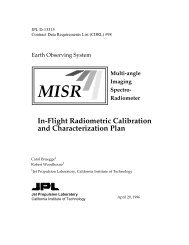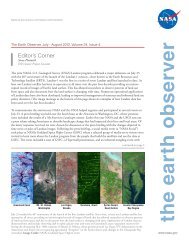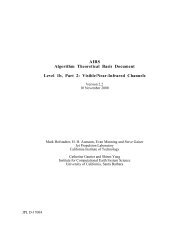90 ATBD-<strong>OMI</strong>-02km. So far, there is no evidence that the profile algorithm will be able to do significantly betterbelow 20 km than the total O 3 -dependent climatology described in Chapter 2. Though it cancertainly do better at higher altitudes, the profile above 20 km, does not become important fortotal O 3 retrieval until the slant column density (SCD) of O 3 becomes quite large. For TOMS V8this happens when SCD>3000, which typically occurs at solar zenith angles >82°, affecting onlyfew percent of the <strong>OMI</strong> data. The situation should be roughly the same for the DOAS algorithm.Therefore, the <strong>OMI</strong>-derived O 3 profiles would be useful only at very large solar zenith angles tocorrect TOMS and DOAS total O 3 .6.3. Combining TOMS and DOAS algorithmsA key difference between the TOMS and the DOAS algorithms is that TOMS takesadvantage of the strong continuum absorption of O 3 in the Huggins band (310-340 nm), whilethe DOAS algorithm uses the much weaker band absorption. As shown in Fig 6-1, the totalabsorption of the radiation is more than an order of magnitude larger than the differentialabsorption near 331 nm. Therefore, in principle, an algorithm that takes advantage of the totalabsorption of O 3 near 310 nm should be able to measure total O 3 with far greater precision thanthe DOAS algorithms. There are several reasons why such an algorithm has not yet beenFigure 6-1:The upper panel shows change in absolute radiance produced by 1 DU increase in stratospheric O 3 at45° SZA, nadir view. TOMS total O 3 wavelength is shown by the asterisk. The lower panel showsdifferential absorption obtained by subtracting a quadratic polynomial from the upper curve. <strong>OMI</strong>DOAS algorithm uses wavelengths longer than 331 nm.developed. First, as noted before, removal of continuum absorption from the radiance spectrumalso removes the interfering effects of aerosols, clouds, sea-glint etc.; indeed one removes anysmoothly varying errors in radiative transfer calculations or in the instrument calibration. Thus,apart from errors that might be caused by the Ring Effect, the DOAS algorithm is largelyinsensitive to many forward model and instrument errors that have plagued previous algorithms,such as TOMS, that do not use differential absorption. In order to develop a total-absorptionalgorithm, the forward model must explicitly account for aerosols and clouds (i.e., by treatingthem as Mie scatterers rather than Lambertian reflectors), and the parameters that are needed torun such a model, cloud/aerosol optical depth, single-scattering albedo etc. must be suppliedexternally. As discussed in another ATBD, there are plans to calculate these parameters using theVersion 2 – August 2002
ATBD-<strong>OMI</strong>-02 91longer <strong>OMI</strong> wavelengths. These parameters could be incorporated in the forward model, but withsignificantly added complexity. In addition, total-absorption algorithms require absolute valuesof TOA reflectances, rather than differential reflectances.Given these inherent difficulties in developing a total-absorption algorithm, one maylegitimately question the need for such an algorithm. Given the expected S/N of <strong>OMI</strong>, the DOASalgorithm described in Chapter 3 should provide daily global maps of vertical column density ofO 3 to a precision of ~1%, at spatial resolution of ~25 km. This should be more than sufficient forany conceivable scientific study involving stratospheric column ozone. However, this is not thecase if one is interested in studying tropospheric ozone from <strong>OMI</strong>. From Table 2-1 it can benoted that the short term variation of tropospheric O 3 in the lowest 5 km, as seen by theHohenpeissenberg ozonesonde station, which is located not very far from major industrial areasof Europe, is only about 3 DU (1σ). If one multiplies this number by the layer efficiency factorof 0.5 (described in Section 2.3.1) the expected variation in the total O 3 derived from <strong>OMI</strong>(irrespective of the algorithm used) would be only 1.5 DU (1σ). So, even if one can do a verygood job of removing the UTLS overburden from total O 3 (using other Aura instruments orcloud slicing), the minimum requirement for observing the lower tropospheric O 3 variations, atthe full spatial resolution of <strong>OMI</strong>, is to achieve better than 1 DU precision in measuring total O 3 .Even better precision is required if one wants to study planetary boundary layer O 3enhancements in urban areas using <strong>OMI</strong>. From Fig. 6-1 it is obvious that it would be verydifficult to achieve such high precisions with any differential absorption algorithm, but it may bepossible to do so if one could take advantage of the total absorption of O 3 near 310 nm.6.4. Combining TOR and Profile algorithmsInitially, the profile algorithm is likely to use latitude and season-dependent a priori. Butif the TOR algorithm described in Chapter 5 is successful in showing that other Aura instrumentsare providing accurate estimates of stratospheric column O 3 , one could, in principle, use theentire profile (of both temperature and O 3 ) produced by these instruments as a priori for O 3profile retrieval using <strong>OMI</strong>. This would allow one to combine high spatial resolution informationfrom <strong>OMI</strong> with high vertical resolution information from other Aura instruments in an optimumway.6.5. Full Convergence of the 4 <strong>Algorithm</strong>sAbove we have described three partial convergence scenarios, involving two algorithmsat a time, which could lead to a single converged algorithm. To summarize, it is first necessary todemonstrate that the profile algorithm can reliably correct the total O 3 derived using the two totalO 3 algorithms at large SCDs. Then it is necessary to demonstrate that a reliable algorithm thattakes full advantage of the total absorption of O 3 , rather than differential absorption, can be builtto derive total O 3 with very high precision. Finally, we should consider bringing-in high verticalresolution profile information from other Aura sensors to improve <strong>OMI</strong> profiles, thus achieving aunique multi-instrument algorithm integration that could provide high spatial and high verticalresolution O 3 profiles over the entire globe.Version 2 – August 2002







